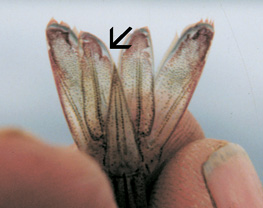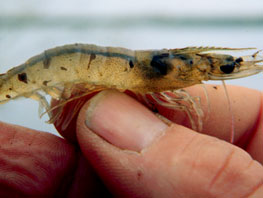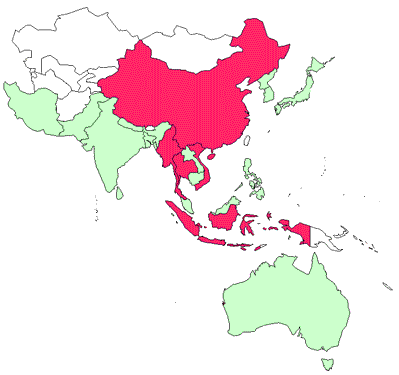Diseases of crustaceans
Viral diseases—Taura syndrome
CLICK ON IMAGE TO ENLARGE

Source: DV Lightner
CLICK ON IMAGE TO ENLARGE

Source: DV Lightner
Signs of disease
Important: animals with disease may show one or more of the signs below, but disease may still be present in the absence of any signs.
Disease signs at the farm level
- lethargy
- cessation of feeding
- animals gather at pond edge when moribund
Clinical signs of disease in an infected animal
- pale red body surface and appendages
- tail fan and pleopods particularly red
- shell soft and gut empty
- death usually at moulting
- multiple irregularly shaped and randomly distributed melanised cuticular lesions
Disease agent
Taura syndrome is caused by Taura syndrome virus (TSV), a small picorna-like RNA virus that has been classified in the new family Dicistroviridae.
Host range
Crustaceans known to be susceptible to Taura syndrome:
blue shrimp* (Penaeus stylirostrus)
Pacific white shrimp* (Penaeus vannamei)
Chinese white shrimp (Penaeus chinensis)
giant black tiger prawn (Penaeus monodon)
Kuruma prawn (Penaeus japonicus)
northern brown shrimp (Penaeus aztecus)
northern pink shrimp (Penaeus duorarum)
northern white shrimp (Penaeus setiferus)
southern white shrimp (Penaeus schmitti)
* naturally susceptible (other species have been shown to be experimentally susceptible)
Presence in Asia–Pacific

Taura syndrome virus has been officially reported from Burma (Myanmar), China, Indonesia, Thailand and Vietnam.
Epidemiology
- Taura syndrome is a disease of the nursery phase of the Pacific white shrimp. It usually occurs within 14–40 days of stocking postlarvae into grow-out ponds or tanks, with mortality of 40–90%.
- TSV can persist outside a host and retain infectivity at experimental temperatures between 0°C and 121°C.
- Transmission is horizontal through ingestion. Although vertical transmission is suspected, it has not been demonstrated.
- Migratory birds, aquatic insects and humans are likely mechanical vectors of the disease.
- Resistance of the giant black tiger prawn and the Kuruma prawn to TSV is unclear, but they appear to be more resistant than the Pacific white shrimp.
- Individuals surviving the chronic phase of Taura syndrome are thought to be carriers of the virus.
Differential diagnosis
The differential diagnostic table and the list of similar diseases appearing at the bottom of each disease page refer only to the diseases covered by this field guide. Gross signs observed might well be representative of a wider range of diseases not included here. Therefore, these diagnostic aids should not be read as a guide to a definitive diagnosis, but rather as a tool to help identify the listed diseases that most closely account for the gross signs.
Similar diseases
Sample collection
Because of uncertainty in differentiating diseases using only gross signs, and because some aquatic animal disease agents might pose a risk to humans, you should not try to collect samples unless you have been trained. Instead, you should phone your national hotline number and report your observations. If samples have to be collected, the agency taking the call will advise you on what you need to do. Local or district fisheries/veterinary authorities could advise you on sampling.
Emergency disease hotline
For your national emergency disease hotline number, see Whom to contact if you suspect a disease.
Further reading
http://www.oie.int/aac/eng/cards/en_diseasecard.htm
The currently accepted procedures for a conclusive diagnosis of TSV are summarised at http://www.oie.int/eng/normes/fmanual/A_00048.htm
These hyperlinks were correct and functioning at the time of publication.

